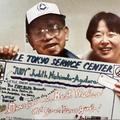When my uncle in Tokyo spotted me in Narita Airport in Japan, he almost breathed a sigh of relief. “Oh, you are like the old model,” he said, picking up my carry-on baggage.
I was 21 years old, and too busy absorbing the rush of businessmen and tourists to register what he said. Later his words were interpreted by my aunt. Although they had seen me when I was 14, they feared that somehow the American air would kick in during my adolescence, transforming me into a bosomy, long-legged Wonder Woman seductress. But I was like Japan’s “old model” female: short, round-faced, and freckled with a healthy pair of daikon ashi (white-radish legs), usually seen half-submerged in rice paddies. And, well, the bosom, I wouldn’t even get into that.
Most Japanese Americans 40 or older understand the term, daikon ashi. Go to any Japanese grocery store and you can’t miss daikon. Piled like logs, perhaps next to hairy balls of sato imo (taro), these are not the cute bunches of red-knobbed radishes found in the local grocery store. No, we are talking about a thick, usually dirt-covered root. Wash it off, peel the skin, and there you have my calves.
No women would revel in having daikon ashi. Older men, flushed with beer, use that term to disparage a woman’s body. In California, we second and third generations have picked it up. Growing up and playing basketball, we girls would tease one another, pointing at our well-endowed calves stuffed like sausages into our tight tube socks. Later, approaching womanhood, we would hope our calves would magically melt away into the more svelte western model a la Barbie. But that day never arrived for some of us.
I don’t hear much about daikon ashi these days. Perhaps it’s because women’s bodies have indeed changed over the past 40 years. I see the willowy teen figures in coffeehouses and malls. These gorgeous Asian American women, stylishly clad in black and light lipstick, are thin as coat hangers. I look at them not with envy, but amazement, that their graceful frames are a result of a similar gene pool as mine. And their legs—no one would mistaken them for giant white radishes, but maybe fast-food drink straws.
Even the look of Japanese girls, especially in the urban areas like Tokyo, has been updated. Their black-and-white uniform are loose on their long and lanky bodies. Some people have told me it’s because they now exercise more; some have comment on their diets. Who knows how long this will continue as mayonnaise and fast food permeate their daily lives?
All these thoughts about body image and type came to a head when I joined a gym in Pasadena. I had a free session with a pert, blond personal trainer. As she used metal clamp to calculate my body fat and a tape measure for my waist, she then looked down at my legs. “My husband would die for your calves.”
“Really.” I didn’t know if it was a sales pitch or honest admiration.
Her body-builder husband, no matter how hard he tried, could not build up his calves, she explained. They remained so thin that socks would fall loose around his ankles.
A peculiar problem, I thought to myself. As she asked me if I’ve ever been injured, it dawned on me that I hadn’t ever broken a bone or torn a single ligament, in spite of years of exercising.
Somehow, I thought, it all goes back to those trusty daikon ashi, which served millions of peasants well back in Meiji Japan.
Now my pet project is to further develop my muscular calves. Who knows? Like the VW Bug, maybe the “old model” will be in some day.
*This article was originally published in Pacific Citizen (print edition) and digitally on Murderati on September 6, 2006.
© 2006 Naomi Hirahara





